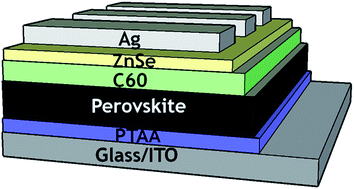Highly efficient and stable inverted perovskite solar cells with two-dimensional ZnSe deposited using a thermal evaporator for electron collection†
Abstract
Hybrid organic–inorganic perovskite solar cells (PSCs) have been attracting great attention. A conjugated organic molecule, bathocuproine (BCP), is often deposited on C60 for electron collection in inverted PSCs. But organic molecules are not stable against UV light and cannot act as good barrier layers to protect the perovskite layer. In principle, inorganic materials can have better stability, but the thermal deposition of inorganic materials usually requires very high temperature. In this work, zinc selenide (ZnSe), a two-dimensional (2D) II–VI semiconductor material with a wide bandgap and high electron mobility, is investigated for electron collection in PSCs without BCP. The ZnSe layer is deposited by using a normal thermal evaporator. The PSCs with ZnSe can exhibit a power conversion efficiency (PCE) of 18.38%, comparable to that with BCP. In addition, the former has better stability than the latter. We also demonstrate PSCs with inorganic materials for both hole and electron collection.



 Please wait while we load your content...
Please wait while we load your content...